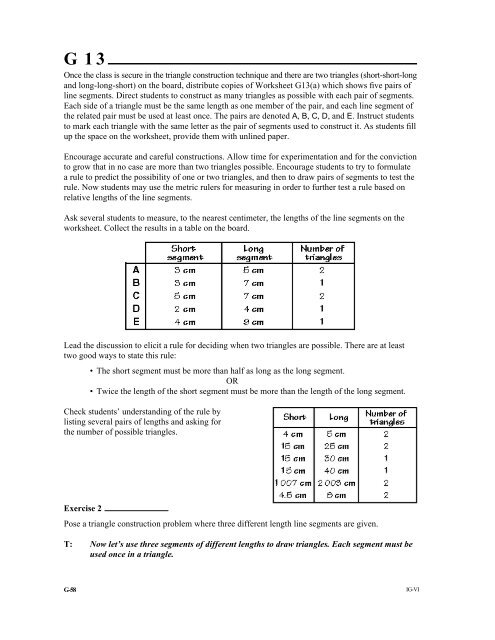Breaking the Stick
Breaking the Stick
Breaking the Stick
You also want an ePaper? Increase the reach of your titles
YUMPU automatically turns print PDFs into web optimized ePapers that Google loves.
G 1 3<br />
Once <strong>the</strong> class is secure in <strong>the</strong> triangle construction technique and <strong>the</strong>re are two triangles (short-short-long<br />
and long-long-short) on <strong>the</strong> board, distribute copies of Worksheet G13(a) which shows five pairs of<br />
line segments. Direct students to construct as many triangles as possible with each pair of segments.<br />
Each side of a triangle must be <strong>the</strong> same length as one member of <strong>the</strong> pair, and each line segment of<br />
<strong>the</strong> related pair must be used at least once. The pairs are denoted A, B, C, D, and E. Instruct students<br />
to mark each triangle with <strong>the</strong> same letter as <strong>the</strong> pair of segments used to construct it. As students fill<br />
up <strong>the</strong> space on <strong>the</strong> worksheet, provide <strong>the</strong>m with unlined paper.<br />
Encourage accurate and careful constructions. Allow time for experimentation and for <strong>the</strong> conviction<br />
to grow that in no case are more than two triangles possible. Encourage students to try to formulate<br />
a rule to predict <strong>the</strong> possibility of one or two triangles, and <strong>the</strong>n to draw pairs of segments to test <strong>the</strong><br />
rule. Now students may use <strong>the</strong> metric rulers for measuring in order to fur<strong>the</strong>r test a rule based on<br />
relative lengths of <strong>the</strong> line segments.<br />
Ask several students to measure, to <strong>the</strong> nearest centimeter, <strong>the</strong> lengths of <strong>the</strong> line segments on <strong>the</strong><br />
worksheet. Collect <strong>the</strong> results in a table on <strong>the</strong> board.<br />
Lead <strong>the</strong> discussion to elicit a rule for deciding when two triangles are possible. There are at least<br />
two good ways to state this rule:<br />
• The short segment must be more than half as long as <strong>the</strong> long segment.<br />
OR<br />
• Twice <strong>the</strong> length of <strong>the</strong> short segment must be more than <strong>the</strong> length of <strong>the</strong> long segment.<br />
Check students’ understanding of <strong>the</strong> rule by<br />
listing several pairs of lengths and asking for<br />
<strong>the</strong> number of possible triangles.<br />
Exercise 2<br />
Pose a triangle construction problem where three different length line segments are given.<br />
T: Now let’s use three segments of different lengths to draw triangles. Each segment must be<br />
used once in a triangle.<br />
G-58 IG-VI

















